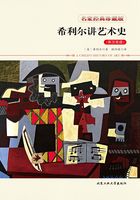
第3章 基路伯与国王
你们会讲亚述语吗?说什么?当然不会?但我敢肯定,即便是已经忘记了亚述这个国家,你们也至少知道一个亚述语单词呢。亚述是一个与埃及一样历史悠久的文明古国,位于埃及以东一千英里的地方。我认为你们应该知道的这个亚述语单词,就是“基路伯”。
如今,我们把那种长着翅膀的天使叫作基路伯。有的时候,一个长得非常漂亮的婴儿,也会被人们称为基路伯呢。可亚述语中的基路伯,却既非小天使,也非小宝宝。它是神话传说中的一种野兽,要么是一头狮子,要么是一头公牛,并且都有着人类的脑袋和老鹰的翅膀。有的时候,我们也用“精灵”这个词来指亚述语中的这种基路伯;它们就像是你们摸过一盏神灯后,可能会突然现身并要你们说出三个愿望的那种精灵一样。
在古亚述,基路伯或者精灵都是用汉白玉制作而成的。汉白玉是一种石头,通常都是白色的,并且质地不像古埃及人所用的绝大部分石头那样坚硬。
古埃及人制作的斯芬克斯,是一种卧着的人首狮身雕像。而古亚述人制作的基路伯,则是一尊站立着的人首狮身雕像。下图所示即为古亚述人制作出来的一尊基路伯。请注意,这尊雕像的头发和胡须,卷曲得多么仔细和严实啊。
给你们出一个很容易回答的问题。这尊基路伯雕像的哪个部分有问题呢?答案
person looking at him from the front would see two legs together as if he were standing still, and when looking at him from the side a person would see the animal walking.
The next two pieces of Assyrian sculpture are in low relief. Notice the muscles that these men have.They are different from the Egyptian men, who were shown to be slender and with no muscles.The Assyrians thought that beauty was strength and that to be beautiful, a person must be strong, so they showed their kings with big, bulging muscles.
The Assyrians believed also that hair was another sign of strength and that no real man who could grow a beard would choose to have a smooth, less-manly face. Do you know the Bible story of Samson?His great strength was supposed to be due to his long hair.When it was cut off, he became weak.
Here the men have long hair and long beards tightly curled like ropes. Notice that the eyes are like the Egyptians'-front view on the side view of their heads.The men have more clothing on, too, with tasseled shawls or skirts that come to their ankles and half sandals.They are not altogether barefooted.
The two chief things the Assyrian kings liked to do best-their two chief sports—
就是:它竟然有五条腿!制作这尊雕像的人当然知道,一头公牛只有四条腿,可他们还是给它雕了五条。原因就在于,这样一来,倘若站在雕像前面,我们就会看到它一共有两条腿,仿佛静静地站在那儿不动似的;而倘若从侧面去看,我们就会看到这头神兽正在走路呢。

古亚述人制作的基路伯,现存于伦敦的大英博物馆
下面这两座由古亚述人制作的雕塑,都属于浅浮雕。注意浮雕中那些男子的肌肉。他们不同于古埃及人,后者通常都显得身材修长,并且看不出肌肉来。而古亚述人认为力量就是美,一个人只有身材强壮才算得上美;因此,他们雕刻出来的国王形象都孔武有力,个个都有着大块隆起的肌肉。
古亚述人还认为,头发是力量的另一种标志,并且没有哪一个能够长出一丛胡须的人愿意剃去胡须,愿意让自己的脸庞变得光滑顺溜和没有阳刚之气。你们听说过《圣经》中关于大力士参孙的故事吗?人们认为,参孙之所以力大无穷,就在于他有一头长发。头发剪短之后,他就变得虚弱无力了。
这里的男子都留着长发和长须,并且把它们像绳子一样紧紧地缠了起来。注意,浮雕上人物的眼睛跟古埃及人制作的那些浮雕相似,也是头部是侧像,眼睛却是正面像。浮雕中人物身上穿着的衣物,也比古埃及人制作的雕像人物身上的衣物多,既有垂着穗带且直达脚踝处的披肩或裙摆,脚上还穿着露趾的拖鞋。他们可不是全然光着脚呢。
古亚述的国王们最喜欢干的两件大事,就是猎杀野兽和在战斗中杀戮敌人;这
were hunting animals and killing their enemies in battle, so most of their reliefs show them doing these things.But the best things the Assyrian artists made were figures of animals.They made them much more lifelike than those of the Egyptians.In many reliefs the horses are fine spirited steeds, and their manes and tails are tightly curled.
The Assyrians also made tiny reliefs on the curved surfaces of cylindrical-shaped pieces of stone or clay. A small axle was put through a hole in the center of the cylinder.The cylinder then became a tiny rolling pin that could be rolled over any soft surface such as mud or wax to leave a flat imprint of the picture on the cylinder.
In this way they could make as many small reliefs as they pleased. We think, however, they used these cylinders as seals to sign their writing.They did not write on paper since they had none.They wrote on mud bricks before the bricks were dried, and they stamped their seal at the end instead of signing their names.
Today in Japan and China, artists sign their names with a stamp made of carved stone called a chop. If you have seen a round or square symbol made with red-orange ink on the

阿苏尔纳西尔帕二世的浮雕,现存于伦敦的大英博物馆(由波士顿的大学印刷协会提供)

阿苏尔纳西尔帕二世猎狮图,现存于伦敦的大英博物馆(由缅因州桑福德的大学印刷协会提供)
也是他们两种主要的娱乐活动,因此他们命人制作出来的浮雕上,绝大部分都是表现他们做这些事情时的场景。不过,古亚述的艺术家们最擅长制作的,还是动物雕像。他们制作出来的动物雕像,比古埃及人制作出来的要逼真得多。在许多浮雕作品中,马匹都是生龙活虎的骏马,而马匹的鬃毛和尾巴也都是严严实实地卷曲着的。
古亚述人也曾在柱状石料或柱状陶土的曲面上制作微型浮雕。他们会用一根细细的轴,穿过一个纵贯柱体中心的洞。这样一来,柱体就变成了一根细细的擀面杖,可以在任何柔软的表面滚动,比如湿泥或者蜂蜡,从而将柱体上的图案浅浅地压印出来了。
用这种办法,他们就可以随心所欲地制作出许多的微型浮雕了。然而,我们却认为,他们是用这些柱状浮雕来做印章,代替他们的签名的。由于当时还没有纸张,因此他们并不是在纸上写字。他们是在还没有干的泥块上写字,而在结尾处也并不是签下自己的大名,而是盖上自己的这种印章。
如今,在日本和中国,艺术家们也都是用一种叫作“图章”的石刻印章来签名的哩。假如在一幅水彩画或者版画的一角看到有一个由橘红色油墨形成的圆形或方
comer of a watercolor or block print, you know just what I mean.
These sculptures of the Assyrians have been dug up from the ruins of their old cities, carried away, and placed in museums. So if you want to see them, you must go not to Assyria but to the British Museum in London, the Louvre Museum in Paris, the Metropolitan Museum of Art in New York, the Walters Art Museum in Baltimore, Maryland, or to other great museums.
From what I have told you of Assyrian sculpture, how would you describe it in a few words?

美索不达米亚的柱状印章,现存于马里兰州巴尔的摩的沃尔特斯艺术博物馆

古巴比伦的经济文件,现存于马里兰州巴尔的摩的沃尔特斯艺术博物馆
形标志,那么你们就会明白我的意思了。
古亚述人制作出来的这些雕塑,被人们从一些古城的废墟之下挖掘出来,带走并放进了博物馆。因此,假如想要看一看这些雕塑,你们大可不必前往亚述古国,只需到伦敦的大英博物馆、巴黎的卢浮宫、纽约的大都会艺术博物馆、马里兰州巴尔的摩的沃尔特斯艺术博物馆,或者其他一些大型博物馆去看看就行了。
根据上面我对古亚述雕塑艺术的介绍,你们又怎样用几句话来加以总结呢?可以参考下面这种方式:
And that's about all we know of Assyrian sculpture. There are not many remains left to tell the tale of the proud, powerful, and cruel tyrants who ruled over millions of people.These monarchs and their subjects have been dead for thousands of years.
Perhaps you think some things you are familiar with will last forever too. Can you name some of them?Imagine that a boy or girl in Assyria must have thought the very same thing about what they saw around them, but those things have practically all disappeared.
对于古亚述的雕塑艺术,我们了解到的情况就是这些了。世界上并没有留下多少遗迹,可以来讲述那些曾经统治着数百万民众、神气十足、强大有力而残酷无比的暴君们的故事。这些暴君,连同他们的子民,都已经死去好几千年了。
你们或许会认为,你们所熟悉的一些东西会永远存在下去。你们能说出一些这样的东西来么?想象一下,亚述古国的一位小朋友对周围所见的一切必定也怀有同样的想法呢;只不过,他所看到的那些东西,事实上都已经消失得无影无踪了。